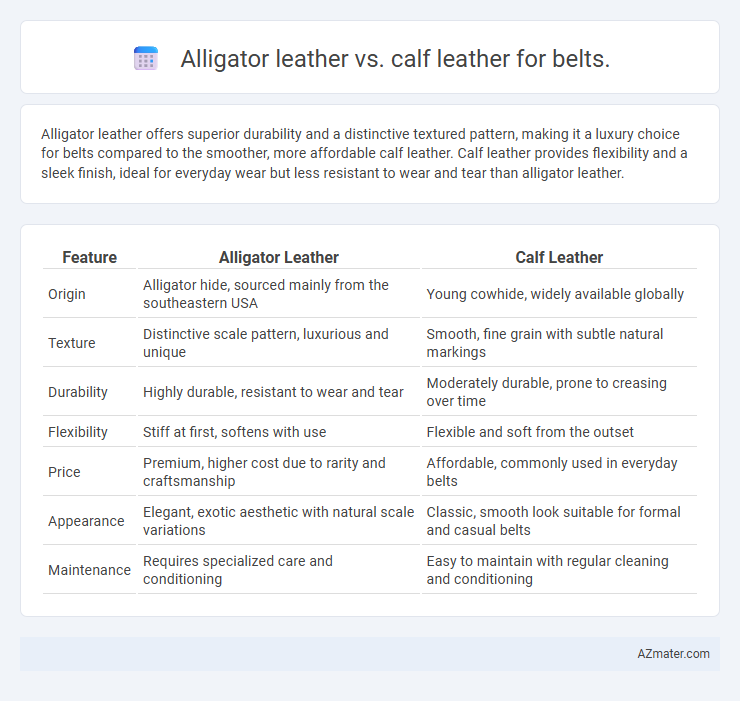Alligator leather offers superior durability and a distinctive textured pattern, making it a luxury choice for belts compared to the smoother, more affordable calf leather. Calf leather provides flexibility and a sleek finish, ideal for everyday wear but less resistant to wear and tear than alligator leather.
Table of Comparison
| Feature | Alligator Leather | Calf Leather |
|---|---|---|
| Origin | Alligator hide, sourced mainly from the southeastern USA | Young cowhide, widely available globally |
| Texture | Distinctive scale pattern, luxurious and unique | Smooth, fine grain with subtle natural markings |
| Durability | Highly durable, resistant to wear and tear | Moderately durable, prone to creasing over time |
| Flexibility | Stiff at first, softens with use | Flexible and soft from the outset |
| Price | Premium, higher cost due to rarity and craftsmanship | Affordable, commonly used in everyday belts |
| Appearance | Elegant, exotic aesthetic with natural scale variations | Classic, smooth look suitable for formal and casual belts |
| Maintenance | Requires specialized care and conditioning | Easy to maintain with regular cleaning and conditioning |
Introduction to Alligator Leather and Calf Leather
Alligator leather, derived from the American alligator's hides, is prized for its distinctive scale patterns, exceptional durability, and luxurious appeal, making it a premium choice for high-end belts. Calf leather, obtained from young cows, is celebrated for its smooth texture, suppleness, and strength, offering a refined and comfortable option for daily wear belts. The unique characteristics of alligator leather provide a bold, exotic look, whereas calf leather ensures versatility and classic elegance in belt design.
Origin and Sourcing of Alligator and Calf Leather
Alligator leather originates primarily from the southeastern United States, where regulated farming ensures sustainable sourcing and strict adherence to CITES regulations, preserving wild populations. Calf leather is sourced mainly from young cattle raised globally, with major suppliers including Europe, the Americas, and Australia, benefiting from abundant livestock farming. The controlled, premium nature of alligator leather contrasts with the widespread availability and diverse sourcing channels of calf leather, influencing price and market positioning for belts.
Distinctive Appearance and Texture
Alligator leather features a distinctive, irregular scale pattern with a glossy finish, offering a luxurious and exotic appearance that stands out on belts. Calf leather boasts a smooth, fine-grain texture with a matte or semi-gloss surface, providing a classic and refined look that ages gracefully over time. The tactile difference is pronounced, as alligator leather feels firmer and more textured, while calf leather is softer and more pliable, catering to different preferences in belt design.
Durability and Longevity Comparison
Alligator leather offers superior durability compared to calf leather due to its dense, tightly woven scales that resist abrasion and wear, making it ideal for long-lasting belts. Calf leather, while softer and more flexible, tends to show signs of aging and creasing over time, reducing its lifespan relative to alligator leather. The natural toughness and resistance to stretching of alligator leather ensure that belts maintain their shape and structural integrity far longer than those made from calf leather.
Comfort and Flexibility for Daily Wear
Alligator leather offers a luxurious texture with moderate flexibility, making it durable but less supple for extended daily wear compared to calf leather. Calf leather, known for its softness and natural pliability, provides superior comfort by molding easily to the waist and bending without stiffness. For everyday belts, calf leather's lightweight and breathable qualities ensure enhanced comfort and flexibility throughout long periods of use.
Cost Analysis: Alligator vs Calf Leather Belts
Alligator leather belts command a significantly higher price due to their rarity, unique texture, and durability, often costing three to five times more than calf leather belts. Calf leather is widely available and less expensive to produce, making it a cost-effective choice for everyday use without sacrificing quality and comfort. Investing in alligator leather belts is typically viewed as a luxury purchase, justified by long-term wear and exclusivity, while calf leather offers affordability and versatility for budget-conscious consumers.
Maintenance and Care Requirements
Alligator leather belts require specialized care to maintain their natural oils and prevent drying or cracking, often involving the use of conditioner specifically designed for exotic leathers. Calf leather belts are generally easier to maintain with regular cleaning and occasional application of standard leather conditioner to preserve softness and prevent wear. Both types should be kept away from excessive moisture and direct sunlight to prolong their lifespan and maintain appearance.
Sustainability and Ethical Considerations
Alligator leather belts, sourced from farmed alligators, often involve regulated wildlife practices but raise concerns about animal welfare and habitat impact. Calf leather, typically a byproduct of the beef industry, depends heavily on industrial scale farming with associated environmental challenges such as high water usage and greenhouse gas emissions. Both materials present ethical considerations; however, choosing vegetable-tanned calf leather or certified sustainable alligator leather can mitigate some environmental and ethical issues.
Popular Brands and Market Trends
Alligator leather belts, favored by luxury brands like Hermes and Gucci, showcase exceptional texture and durability, commanding premium prices in the high-end market. Calf leather, widely used by popular brands such as Coach and Fossil, offers versatility and affordability, making it dominant in mainstream fashion trends. Market analysis reveals growing consumer preference for exotic alligator leather belts due to exclusivity, while calf leather maintains strong demand owing to its classic style and cost-effectiveness.
Choosing the Right Leather Belt for Your Needs
Alligator leather belts offer unmatched luxury with distinctive scale patterns and superior durability, making them ideal for formal occasions and long-lasting wear. Calf leather belts provide a smooth texture and versatility, perfect for everyday use due to their softness, affordability, and ability to age gracefully. Selecting between alligator and calf leather depends on balancing style, budget, and intended usage, ensuring the belt complements both your wardrobe and practical needs.

Infographic: Alligator leather vs Calf leather for Belt
 azmater.com
azmater.com